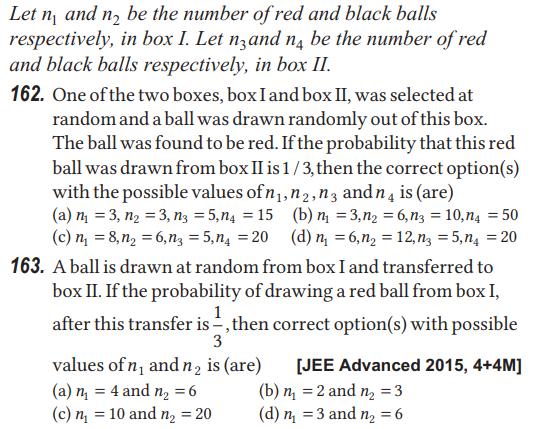Answered step by step
Verified Expert Solution
Question
1 Approved Answer
Let n and n be the number of red and black balls respectively, in box I. Let n3and n4 be the number of red

Let n and n be the number of red and black balls respectively, in box I. Let n3and n4 be the number of red and black balls respectively, in box II. 162. One of the two boxes, box I and box II, was selected at random and a ball was drawn randomly out of this box. The ball was found to be red. If the probability that this red ball was drawn from box II is 1/3, then the correct option(s) with the possible values of n, n, n3 and n4 is (are) (a) n = 3, n = 3, n3 = 5,4 = 15 (b) n = 3,n = 6,n3 = 10,4 = 50 (c) n = 8,n = 6,n3 = 5,n4 = 20 (d) n = 6,n = 12,n3 = 5, n = 20 163. A ball is drawn at random from box I and transferred to box II. If the probability of drawing a red ball from box I, 1 after this transfer is -, then correct option(s) with possible 3 values of n, and n2 is (are) (a) n = 4 and n = 6 (c) n = 10 and n = 20 [JEE Advanced 2015, 4+4M] (b) n = 2 and n = 3 (d) n = 3 and n = 6
Step by Step Solution
★★★★★
3.34 Rating (154 Votes )
There are 3 Steps involved in it
Step: 1
The detaile...
Get Instant Access to Expert-Tailored Solutions
See step-by-step solutions with expert insights and AI powered tools for academic success
Step: 2

Step: 3

Ace Your Homework with AI
Get the answers you need in no time with our AI-driven, step-by-step assistance
Get Started


